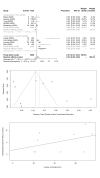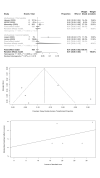SARS-CoV-2 transmission in schools: An updated living systematic review (version 2; November 2020)
- PMID: 34804514
- PMCID: PMC8590829
- DOI: 10.7189/jogh.11.10004
SARS-CoV-2 transmission in schools: An updated living systematic review (version 2; November 2020)
Abstract
Background: Better understanding of SARS-CoV-2 transmission risks is needed to support decision-making around mitigation measures for COVID-19 in schools.
Methods: We updated a living systematic review and meta-analysis to investigate the extent of SARS-CoV-2 transmission in schools. In this update we modified our inclusion criteria to include: 1) cohort studies; 2) cross-sectional studies that investigated and cross-assessed SARS-COV-2 positivity rates in schools and communities; and 3) pre-post studies. We performed risk of bias evaluation for all included studies using the Newcastle-Ottawa Scale (NOS).
Results: 6270 articles were retrieved and six new studies were added in this update. In total from the two updates and using the new inclusion criteria, we identified 11 cohort studies (1st update: n = 5; 2nd update: n = 6) and one cross-sectional study (1st update: n = 1; 2nd update: n = 0). We performed a meta-analysis on nine of the 11 cohort studies investigating IAR in schools. Nine cohort studies reported a total of 91 student and 52 staff index cases that exposed 5698 contacts with 101 secondary infections (overall infection attack rate (IAR) = 1.45%, 95% CI = 0.31%-3.26%). IARs for students and school staff were 1.66% (95% CI = 0.08%-4.78%) and 1.18% (95% CI = 0.00%-4.43%) respectively. The risk of bias was found to be high for most studies identified, limiting the confidence in results.
Conclusions: There is limited high-quality evidence available to quantify the extent of SARS-CoV-2 transmission in schools or to compare it to community transmission. Emerging evidence suggests the overall IAR and SARS-CoV-2 positivity rate in school settings are low. Higher IAR were found in students, compared to staff.
Note: This article is a living systematic review that will be updated to reflect emerging evidence. This is the second version of the original article published on 23 December 2020 (J Glob Health 2020;11:021104), and previous versions can be found as data supplements. When citing this paper please consider adding the version number and date of access for clarity.
Copyright © 2021 by the Journal of Global Health. All rights reserved.
Conflict of interest statement
Competing interests: The authors completed the ICMJE Unified Competing Interest form (available upon request from the corresponding author), and declare no conflicts of interest.
Figures




Similar articles
-
What is the evidence for transmission of COVID-19 by children in schools? A living systematic review.J Glob Health. 2020 Dec;10(2):021104. doi: 10.7189/jogh.10.021104. J Glob Health. 2020. PMID: 33437465 Free PMC article.
-
SARS-CoV-2 infection and transmission in educational settings: a prospective, cross-sectional analysis of infection clusters and outbreaks in England.Lancet Infect Dis. 2021 Mar;21(3):344-353. doi: 10.1016/S1473-3099(20)30882-3. Epub 2020 Dec 8. Lancet Infect Dis. 2021. PMID: 33306981 Free PMC article.
-
SARS-CoV-2 screening testing in schools for children with intellectual and developmental disabilities.J Neurodev Disord. 2021 Sep 1;13(1):31. doi: 10.1186/s11689-021-09376-z. J Neurodev Disord. 2021. PMID: 34465306 Free PMC article.
-
Prevalence of risk behaviors and correlates of SARS-CoV-2 positivity among in-school contacts of confirmed cases in a Georgia school district in the pre-vaccine era, December 2020-January 2021.BMC Public Health. 2022 Jan 14;22(1):101. doi: 10.1186/s12889-021-12347-7. BMC Public Health. 2022. PMID: 35031000 Free PMC article.
-
Risk of infection and contribution to transmission of SARS-CoV-2 in school staff: a systematic review.BMJ Open. 2021 Nov 3;11(11):e052690. doi: 10.1136/bmjopen-2021-052690. BMJ Open. 2021. PMID: 34732489 Free PMC article.
Cited by
-
Behaviors Associated With Household Transmission of SARS-CoV-2 in California and Colorado, January 2021-April 2021.AJPM Focus. 2022 Sep;1(1):100004. doi: 10.1016/j.focus.2022.100004. Epub 2022 May 5. AJPM Focus. 2022. PMID: 36942013 Free PMC article.
-
The Lancet Commission on lessons for the future from the COVID-19 pandemic.Lancet. 2022 Oct 8;400(10359):1224-1280. doi: 10.1016/S0140-6736(22)01585-9. Epub 2022 Sep 14. Lancet. 2022. PMID: 36115368 Free PMC article. Review. No abstract available.
-
Methodological quality and reporting quality of COVID-19 living systematic review: a cross-sectional study.BMC Med Res Methodol. 2023 Jul 31;23(1):175. doi: 10.1186/s12874-023-01980-y. BMC Med Res Methodol. 2023. PMID: 37525117 Free PMC article.
-
Characteristics of Living Systematic Review for COVID-19.Clin Epidemiol. 2022 Aug 4;14:925-935. doi: 10.2147/CLEP.S367339. eCollection 2022. Clin Epidemiol. 2022. PMID: 35958161 Free PMC article.
References
-
- Royal Society DELVE Initiative. Balancing the Risks of Pupils Returning to Schools. Available: https://rs-delve.github.io/reports/2020/07/24/balancing-the-risk-of-pupi.... Accessed: 17 Sep 2020.
Publication types
MeSH terms
Grants and funding
LinkOut - more resources
Full Text Sources
Medical
Miscellaneous
